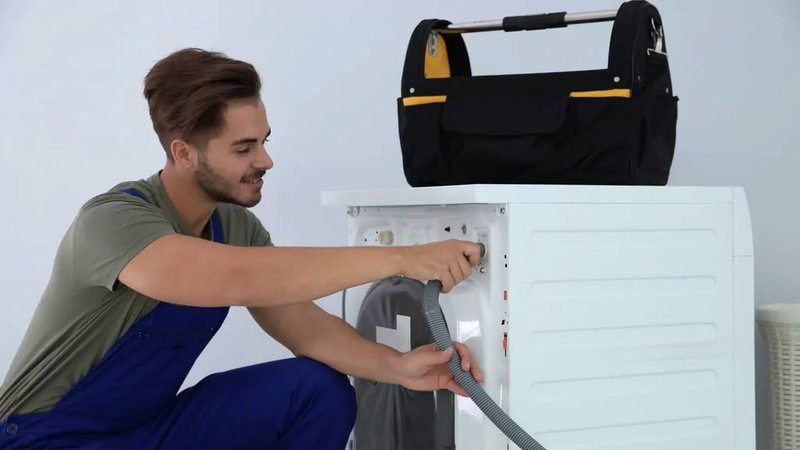
Let’s break down what this error code means. Essentially, the E1 error is a signal from your dryer saying, “Hey, something’s not quite right here.” Imagine it like a car’s check engine light. It doesn’t tell you the exact problem, but it does alert you that further investigation is needed. For most beginners, understanding when to call in the professionals can save you time, frustration, and potentially more costly repairs down the line.
Understanding Bosch Dryer Error Code E1
The E1 error code is primarily associated with a temperature regulation issue in your Bosch dryer. Think of it like your dryer’s internal way of saying, “I’m too hot, and I can’t cool down properly.” This could be due to several factors, all pointing towards the temperature sensor or the wiring connected to it. If your dryer can’t tell how hot it is accurately, it risks overheating, which is never a good thing.
Why is this important? Well, maintaining the right temperature is crucial for a dryer to function properly. Imagine you’re cooking your favorite meal. If the oven doesn’t maintain a steady temperature, that dish won’t come out right. Similarly, this error affects the dryer’s performance, leading to clothes that aren’t dried properly or even damage to the fabric due to overheating.
So, what does this mean for you? It means that there might be a malfunction with the thermostat, thermistor, or even the wiring that helps regulate temperature. Sometimes it’s a simple fix, like cleaning the lint filter, but often professional insight is needed. If you’ve repeatedly cleared the lint and still face the E1 error, it’s a sign that it’s time to consider other possibilities.
Common Causes of the E1 Error
You might be wondering what typically causes the E1 error. First off, let’s talk about airflow. Like any other dryer, your Bosch dryer relies on proper airflow to maintain temperature. A clogged lint filter or vent can restrict this airflow, causing the dryer to overheat. It’s like trying to breathe through a straw — difficult and not very efficient.
Additionally, a faulty temperature sensor could be at play. The sensor acts like the dryer’s “thermometer,” ensuring it doesn’t get too hot. If the sensor is defective, it could send incorrect messages to the dryer’s brain, leading to the E1 alert. The wiring connected to these components can also be a culprit. Wires can become loose or damaged over time, cutting off the critical connection needed for temperature regulation.
Lastly, it’s worth considering external factors like room temperature or obstructed vents. A dryer crammed into a cramped space without proper ventilation may struggle to regulate temperature effectively. Ensuring proper spacing and ventilation can sometimes clear up the issue without further intervention.
When To Call A Technician
Now comes the big question: when should you throw in the towel and call a professional? If you’ve tried cleaning the lint filter and checked for obvious blockages and still see the E1 code, it’s time to consult the experts. They have the tools and experience to diagnose sensor problems, check wiring connections, and re-calibrate your dryer if needed.
Calling a technician is much like consulting a doctor when over-the-counter remedies don’t knock out your cold. These professionals can dig deeper into the intricate workings of your Bosch dryer and provide a solution that restores it to peak performance. You might be tempted to keep troubleshooting on your own, but at some point, expertise is invaluable.
Moreover, continuing to use a dryer flashing an E1 error without proper repair can lead to further damage, higher energy bills, and even safety hazards. Avoid these risks by getting in touch with a reliable appliance repair service to address the issue thoroughly.
Preventive Tips to Avoid Future E1 Errors
To keep your Bosch dryer running smoothly in the future, there are a few straightforward preventive measures you can take. Regular maintenance is key. Make it a habit to clean the lint filter after each use. This simple step ensures that airflow remains unobstructed, which is crucial for your dryer’s temperature regulation.
Also, periodically check the dryer vent for any blockages. Imagine a garden hose with a kink in it — water won’t flow efficiently, right? The same goes for your dryer vent; it needs to be clear to function properly. Ensuring the vent isn’t obstructed by lint or debris can help prevent overheating and the dreaded E1 code.
Finally, consider having your dryer inspected annually by a professional technician. Just like your car needs a regular service to keep it running smoothly, a yearly check-up for your dryer can catch issues before they turn into costly repairs. It’s a small investment for peace of mind and the longevity of your appliance.
In conclusion, while the Bosch dryer E1 error code can be frustrating, understanding what it means and knowing when to call a technician can save you time and hassle. Regular maintenance and professional check-ups are your best defenses against future errors, ensuring your dryer runs efficiently for many loads to come.